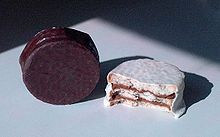Alfajor
An alfajor is a pastry of Moorish-Spanish origin. Nowadays it is a typical product of southern Latin America , where it is usually made as a double biscuit and often a filling made from dulce de leche is used.
history
After the conquest of Spain by the Moors in the 8th century, a pastry called Alajú , which they introduced, became known, regionally it is still called that, but the name Alfajor largely prevailed. The word may also go back to the Hispano -Arabic term al-hasu ("filling"). The Andalusian Medina-Sidonia and Murcia are known for the pastries. The Spaniards brought it to Latin America, where its recipe has been greatly changed and now mostly has the shape of a double biscuit. German-language baking recipes almost always refer to this South American version.
Ingredients and manufacture
There are many variations of the pastry. Many are made from shortcrust pastry . In addition to flour, butter, sugar, baking soda and baking powder, raisins, honey and lemon are often used. Most Spanish recipes contain almonds, some figs and sherry as well . Corn starch and dulce de leche, on the other hand, are typical Latin American ingredients, sometimes coconut flakes are also used.
Individual evidence
- ↑ [1]
- ↑ Kekstester.de
- ↑ Felipa Mailló Salgado: Los arabismos del castellano en la Baja Edad Media . University of Salamanca, 1983, p. 91 ff .
- ↑ Chefkoch.de
- ↑ [2]
